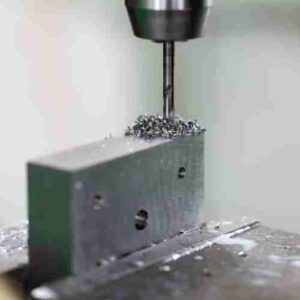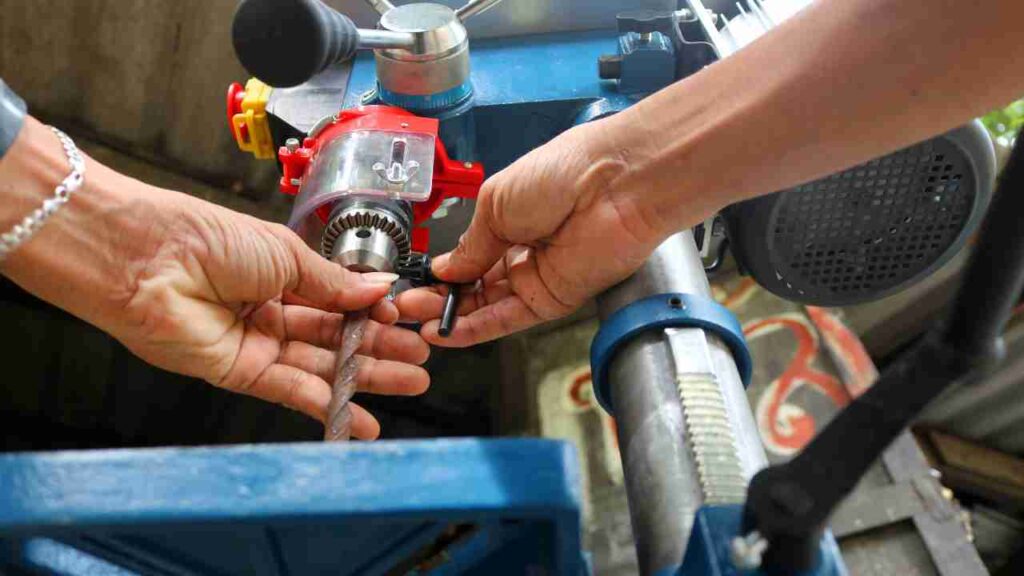In metalworking, mastering your tools can mean the difference between a perfect, seamless project and one marred by errors and inefficiencies. One such tool that demands this mastery is the drill press. When dealing with hardy materials like steel, your drill speed can significantly impact your results.
Correctly calibrated, your drill press can effortlessly slice through steel, creating clean, accurate holes. But set the speed incorrectly, and you risk damaging your tools, workpiece, or yourself. Today, we’ll delve into the nuances of setting the perfect drill press speed for steel, a skill that will elevate your metalworking projects to new heights of precision and quality.
Drill Press Speed for different materials:
| Material | Recommended Drill Press Speed Range |
|---|---|
| Steel | 500-3000 RPM |
| Wood | 1000-3000 RPM |
| Plastic | 1500-4000 RPM |
| Aluminum | 2000-5000 RPM |
| Brass | 1500-4000 RPM |
 Importance of Selecting the Proper Drill Press Speed:
Importance of Selecting the Proper Drill Press Speed:
Choosing the right speed for your drill press is not just a matter of efficiency – it’s a critical factor that influences the quality of your work and the longevity of your tools. When drilling through steel, this selection becomes even more crucial.
How Correct Speed Improves Efficiency and Tool Lifespan
The correct drill press speed for a given material and bit size can make your job easier and faster. It optimizes cutting efficiency, allowing the drill bit to penetrate the steel smoothly and cleanly. The result is a perfect hole and a tool that stays in good shape for longer. Using the right speed minimizes friction and overheating, common causes of premature tool wear and tear.
Potential Risks of Using Incorrect Drill Press Speed
Conversely, you’re heading for trouble if you select a drill press speed that’s too fast for steel. Excessive speed generates high temperatures, damaging the bit and potentially altering the steel’s properties.
You also risk creating rough, inaccurate holes. On the other hand, a speed that’s too slow can strain the motor and result in an inefficient cut. In both scenarios, the added risk of personal injury is a sobering reminder of why getting the speed right is so important.
Working With Steel: Why It’s a Unique Case:
Steel presents a fascinating challenge in drilling for a versatile and ubiquitous material. It’s robust, durable, and comes in various types and grades – all factors influencing the optimal drilling speed.
1. Characteristics of Steel That Make It Distinct for Drilling
Steel is a hard material, much more than wood or most plastics. This hardness means it’s resistant to cutting forces, necessitating a slower drill press speed to ensure clean, accurate holes. But steel isn’t just a single, uniform material.
From mild carbon steel to stainless steel, tool steel to galvanized steel, each variety has unique hardness and machinability that must be considered when selecting drill press speed.
2. The Challenge in Selecting the Right Drill Press Speed for Steel
Despite its challenges, steel is an excellent material for various applications, so knowing how to drill it properly is essential. The drill press speed must be slow enough to prevent overheating the drill bit but fast enough to provide efficient cutting. Striking the right balance is an art form that relies on guidelines, experience, and fine-tuning.
Let’s explore the best practices to achieve the ideal drill press speed for steel.
Guidelines for Drill Press Speed for Steel:
Working with steel requires a careful touch and an understanding of its characteristics. When drilling, the right speed can make all the difference between a clean hole and a botched job. Here are some general guidelines to follow when setting your drill press speed for steel.
General Recommended Speed Ranges for Different Types of Steel
When drilling steel, a general rule of thumb is to aim for a speed range between 50 and 400 revolutions per minute (RPM), depending on the steel type and the drill bit’s size. For instance, softer carbon steels can tolerate slightly higher speeds, while harder stainless steels typically require lower speeds.
Factors to Consider in Setting Drill Press Speed
The exact speed within this range depends on several factors. Drill bit size plays a significant role – smaller bits can handle higher speeds, while larger bits need slower speeds. As mentioned earlier, the type of steel you’re working with also greatly influences the speed selection. Furthermore, cutting fluids or coolants can allow for slightly higher speeds by reducing friction and heat buildup.
How to Adjust Drill Press Speed
Adjusting the speed of your drill press typically involves changing the belt position on the machine’s pulleys. Refer to your drill press’s manual for exact instructions, which can vary depending on the model. Remember, when working with steel, it’s better to start at a slower speed and gradually increase if necessary, always paying attention to the feedback from your drill press and the steel itself.
Expert Tips on Drilling Steel:
Even with the right drill press speed, there’s an art to drilling steel that comes with experience and know-how. Here are some expert tips to help you get the best results.
1. Advice on Selecting Drill Bits for Steel
When drilling steel, the type of drill bit you choose is critical. High-speed steel (HSS) bits are popular due to their durability and heat resistance. For tougher steels, cobalt steel or carbide-tipped bits offer superior hardness. Always ensure your drill bits are sharp; a dull bit requires more force, increases heat, and can lead to rough holes.
2. Recommendations for Drill Press Techniques Specific to Steel
When drilling, apply steady, moderate pressure – too much can dull your bit or even cause it to break, while too little can result in an inefficient cut. Listen to your drill press; it can tell you a lot about what’s happening. A smooth, even sound indicates that you’re drilling at the right speed and applying the correct pressure. You may need to adjust your speed or technique if you hear chattering or see excessive smoke.
3. Importance of Using Coolants or Lubricants
Cutting fluids or coolants is vital when drilling steel. They reduce friction, dissipate heat, and can prolong the life of your drill bit. They also make the drilling process smoother, resulting in cleaner, more accurate holes.
Safety Measures When Using Drill Press with Steel:
Safety should always be your top priority, no matter how proficient you are with your drill press. Drilling steel, with its unique challenges, requires additional caution. Here are key safety measures to keep in mind.
Reminder of the Importance of Safety
Operating any power tool demands respect for the potential hazards involved. With a drill press, the combination of high-speed rotation, sharp drill bits, and hard materials like steel means there’s no room for complacency. Ensuring you’ve set the correct speed is a crucial first step toward safe operation.
Key Safety Measures to Consider While Operating a Drill Press
- Personal Protective Equipment: Always wear safety glasses or face shields to protect your eyes from flying chips. Gloves can protect your hands, but be sure they fit well to avoid getting caught in the drill press.
- Clamping Workpieces: Never hold a workpiece by hand when drilling. Always secure it with clamps or a vise to prevent it from spinning or moving.
- Clear Work Area: Keep your workspace clean and clear of debris. Small metal shavings can become dangerous projectiles if not properly managed.
- Regular Inspection: Inspect your drill press and bits for any signs of wear or damage. A poorly maintained tool can lead to unexpected malfunctions, which can be particularly hazardous when working with tough materials like steel.
- Mind Your Speed: As we’ve discussed, selecting the correct material and bit size speed is crucial for safe and efficient drilling. Too high a speed can cause overheating, damaging your bit and workpiece, and potentially causing injury.
 Conclusion:
Conclusion:
In conclusion, setting the correct drill press speed for steel is a blend of science, experience, and finesse. Understanding the unique properties of steel, the drill bit’s influence and the critical role of speed in the drilling process can lead to exceptional results.
By following the guidelines and tips shared in this post, you’re well on your way to mastering steel drilling – achieving clean, precise holes, extending the lifespan of your tools, and ensuring safety.
So next time you’re faced with a steel project, remember the right speed is your ticket to a job well done.
- Delta Rockwell Drill Press 15 017: Your Ultimate Workshop Tool - August 21, 2023
- Rockwell 32 Radial Drill Press: The Ultimate Workshop Tool - August 21, 2023
- Best Drill Press for 80 Lower: Expert Advice and Top Picks - August 21, 2023






